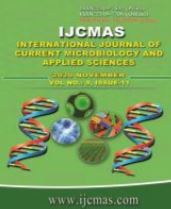


 National Academy of Agricultural Sciences (NAAS)
National Academy of Agricultural Sciences (NAAS)

|
PRINT ISSN : 2319-7692
Online ISSN : 2319-7706 Issues : 12 per year Publisher : Excellent Publishers Email : editorijcmas@gmail.com / submit@ijcmas.com Editor-in-chief: Dr.M.Prakash Index Copernicus ICV 2018: 95.39 NAAS RATING 2020: 5.38 |
Piper betle L., (family- Piperaceae) commonly known as the betel vine is an important medicinal and recreational plant in Southeast Asia. Betel vine is a dioecious, evergreen, perennial creeper with glossy heart shaped leaves. The present study was executed to identify the suitable integrated nitrogen management on leaf yield, quality and economy of betel vine (Piper betle L.) cultivars in new alluvial zone of West Bengal. The field experiment was conducted at Horticulture Research Station, Mondouri, Bidhan Chandra Krishi Viswavidyalaya, Nadia, West Bengal during the 2017-2018. The experiment was laid out in Rnadomized Block Design, replicated thrice with eight treatments of integrated nitrogen management. It was noted that treatments in combination with inorganic and organic sources of nitrogen produced better results than the treatments with sole application of organic source of nitrogen. The application of nitrogen from mustard oil cake and urea in 1:1 ratio (T1) produced maximum leaf yield/ vine (86.45 leaves/ vine/ year), projected leaf yield (63.22 lakhs/ ha/ year), chlorophyll content of the leaves (52.30 SPAD value), Ascorbic acid content of leaves (3.07 mg/100g), essential oil content ( 65.50 mg/100g) and ß Carotene content of leaves (7.28 mg/100g) in Simurali Deshi (V1). Maximum fresh weight (261.25 g) and dry weight (42.01 g) of 100 leaves were found in Halisahar Sanchi (V₃). Among all the sources of nitrogen Mustard oil cake 50% + Urea 50% (Tâ‚Â) showed highest benefit and cost ratio in all the three cultivars.
 |
 |
 |
 |
 |